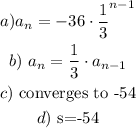Answer:

Explanation:
The explicit and recursive formula for a geometric sequence is represented by the following:

The common ratio of the pattern is:

Then, for the explicit formula:

Recursive formula:

Now, to determine if the pattern converge or diverge:

Since the common ratio is less than 1, the series converges to:

A sum of an infinite geometric series can be determined if it converges since this pattern converges, the sum would converge to;
